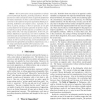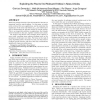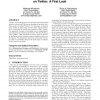134
click to vote
CORR
2011
Springer
14 years 4 months ago
2011
Springer
Many web databases can be seen as providing partial and overlapping information about entities in the world. To answer queries effectively, we need to integrate the information ab...
127
click to vote
ACCV
2010
Springer
14 years 7 months ago
2010
Springer
Abstract. Estimation using homogeneous entities has to cope with obstacles such as singularities of covariance matrices and redundant parametrizations which do not allow an immedia...
120
Voted
EUSFLAT
2009
14 years 10 months ago
2009
Diverse forms of the concept of opposition are already existent in philosophy, linguistics, psychology and physics. The interplay between entities and opposite entities is apparent...
129
click to vote
EMNLP
2009
14 years 10 months ago
2009
Many named entities contain other named entities inside them. Despite this fact, the field of named entity recognition has almost entirely ignored nested named entity recognition,...
112
click to vote
ACL
2009
14 years 10 months ago
2009
Coreferencing entities across documents in a large corpus enables advanced document understanding tasks such as question answering. This paper presents a novel cross document core...
111
Voted
WICON
2010
14 years 10 months ago
2010
In context-aware computing, distributed information about entities, such as people, places and objects, is captured and made available to applications, which utilize this context....
101
Voted
CIKM
2010
Springer
14 years 10 months ago
2010
Springer
Retrieving entities instead of just documents has become an important task for search engines. In this paper we study entity retrieval for news applications, and in particular the...
213
Voted
AND
2010
14 years 10 months ago
2010
Twitter, a micro-blogging service, provides users with a framework for writing brief, often-noisy postings about their lives. These posts are called "Tweets." In this pa...
139
click to vote
WAIM
2010
Springer
14 years 11 months ago
2010
Springer
Abstract. Wikis are currently used in providing knowledge management systems for individual enterprises. The initial explanations of word entries (entities) in such a system can be...
125
Voted
SIGIR
2010
ACM
14 years 11 months ago
2010
ACM
The state-of-the-art in Named Entity Recognition relies on a combination of local features of the text and global knowledge to determine the types of the recognized entities. This...



